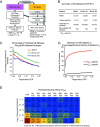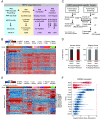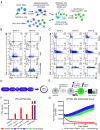IRIS: Discovery of cancer immunotherapy targets arising from pre-mRNA alternative splicing
- PMID: 37192158
- PMCID: PMC10214192
- DOI: 10.1073/pnas.2221116120
IRIS: Discovery of cancer immunotherapy targets arising from pre-mRNA alternative splicing
Abstract
Alternative splicing (AS) is prevalent in cancer, generating an extensive but largely unexplored repertoire of novel immunotherapy targets. We describe
Keywords: RNA splicing; T cell receptors; immunotherapy.
Conflict of interest statement
Y.P., J.W.P., O.N.W., and Y. Xing are inventors on a provisional patent application titled “Compositions and methods comprising splicing-derived antigens for treating cancer.” Y.P., A.H.L., R.M.P., and Y. Xing are inventors on a provisional patent application titled “Identification of splicing-derived antigens for treating cancer.” Z.M., P.A.N., J.M., and O.N.W. are inventors on a provisional patent application titled “Human T cell receptor pairs reactive with HLA-A*02:01 restricted human prostatic acid phosphatase (PAP) epitopes.” A.R. has received honoraria from consulting with Amgen, Bristol-Myers Squibb, and Merck; is or has been a member of the scientific advisory board and holds stock in Advaxis, Appia, Apricity, Arcus, Compugen, CytomX, Highlight, ImaginAb, ImmPact, ImmuneSensor, Inspirna, Isoplexis, Kite-Gilead, Lutris, MapKure, Merus, PACT, Pluto, RAPT, Synthekine, and Tango; and has received research funding from Agilent and from Bristol-Myers Squibb through Stand Up to Cancer (SU2C) and patent royalties from Arsenal Bio. C.S.S. and G.M.C. are cofounders of Pluto Immunotherapeutics. O.N.W. currently has consulting, equity, and/or board relationships with Trethera Corporation, Kronos Biosciences, Sofie Biosciences, Breakthrough Properties, Vida Ventures, Nammi Therapeutics, Two River, Iconovir, Appia BioSciences, Neogene Therapeutics, 76Bio, and Allogene Therapeutics. Y.Xing is a scientific cofounder of Panorama Medicine and consulted for PACT Pharma. None of these companies contributed to or directed any of the research reported in this article. The remaining authors declare no competing interests. S.P.S. coauthored a 2020 review with Y.P., K.E.K.-E., and Y. Xing.
Figures





References
Publication types
MeSH terms
Substances
Grants and funding
LinkOut - more resources
Full Text Sources
Other Literature Sources
Medical
Molecular Biology Databases
Research Materials

